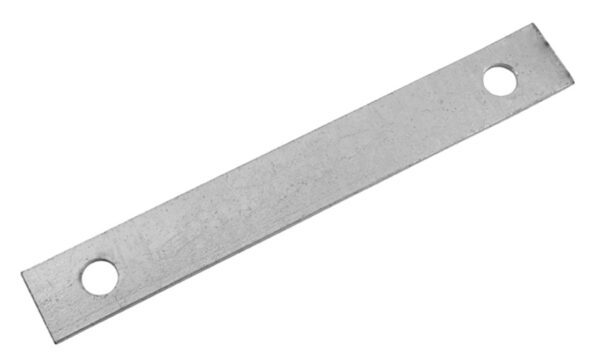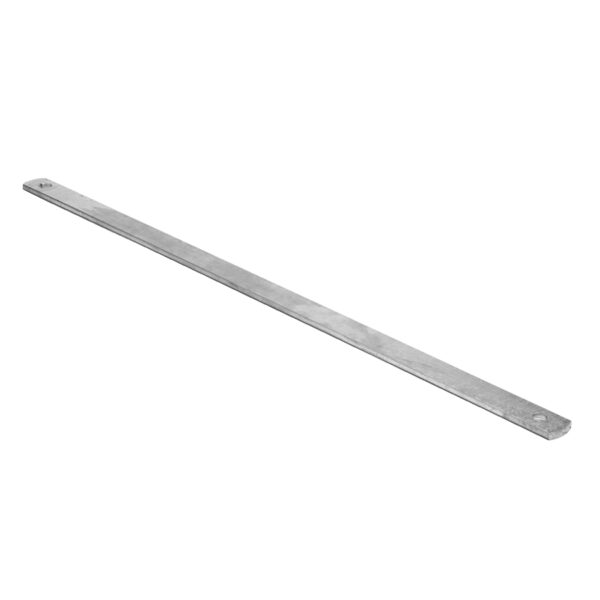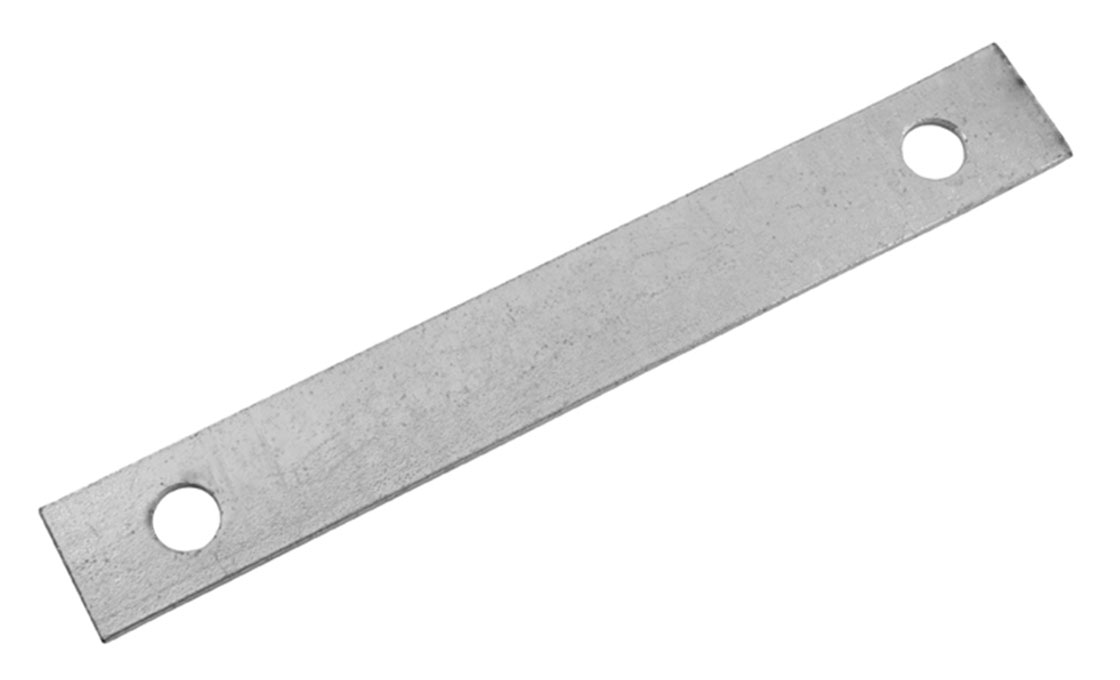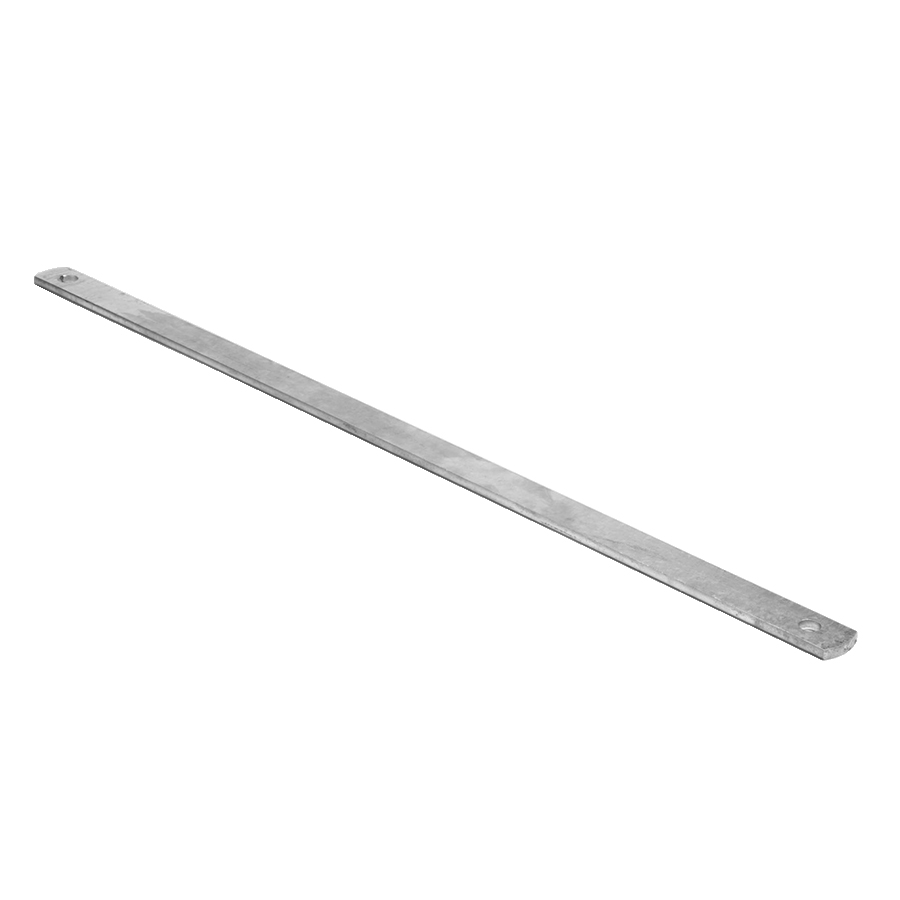Crossarm Braces
- Description
- Specification
Description
Flat crossarm brace has the same function as alley arm brace and angle brace – just different construction.
Crossarm braces connect the electrical crossarm by bolts and nuts. They have the function of supporting the electrical crossarm and making the power pole crossarm firm. They are usually used in pairs.
There are no welded or jointed sections at any place of the crossarm brace. It is a single piece of carbon steel. The length of the crossarm braces is 20,26,28 or 32, and the thickness is 1/4’’. At one end there is a hole of 9/16, while the one at the other end is 7/16.
The raw material of the flat crossarm braces is flat steel. The ultimate tensile strength of the product is 410N/mm2 to 560N/mm2. The Quan Pham Industry QC will test the raw material before mass production.
The final surface of the Quan Pham Industry crossarm brace will be hot dip galvanized in conformance with ISO1461.
Before packing, the Quan Pham Industry QC team will test the strength and the galvanized thickness of the sample. As a leading cross arm manufacturer and supplier, we know the market, process, and your needs. Quan Pham Industry is your reliable choice for all your crossarm braces.
Table of Contents
Crossarm Braces: An Ultimate Guide for Importers
Crossarm braces play an important role in pole line hardware installation.
They make sure that electrical cross arms are strong and firm.
Therefore, you must buy high quality and reliable crossarm braces.
It is important for you to know what it is, the designs, its functionality, and specifications.
This guide will take you through all this information.
For manufacturers, you will also learn how to make cross arm braces.
Now, let’s get to that.
What is a Crossarm Brace?
Cross arm braces are pieces of pole line hardware used to offer extra support to the electrical cross arm.
There are quite many cross-arm braces manufactured using different types of material.
The primary material used include aluminum alloys, preservative – Treated Apitong wood and the most common being flat steel.

Apart from the material used, cross-arm braces are available in different sizes.
The most common formats of cross arm braces are 20, 26, 28 and 32 mm in length with a thickness of ¼ inch.
Crossarm braces are round at the end with a hole of 9/16 inch at one end and 7/16 on the other.
Why You Need Crossarm Braces
The cross-arm braces connect the electrical cross arm using bolts and nuts.
It also supports the electrical cross arm making the power pole cross arms strong.
Flat cross-arm braces are used in pairs making it a cheap means of promoting and aligning cross arms.

The process of hot-dip galvanization gives it a smooth finish making it resistant to corrosion.
It comes as one piece without welding different parts together that would compromise the whole section.
Main Components of Crossarm Braces
Some of the main components of cross arm braces include:
1. Flat bar with holes
Flat bars of the cross arm brace is the main components as they are responsible for holding and supporting the electrical cross-arm.
The holes on both ends allow the bolts to pass through and aid in attaching them to the pole.
The flat nature makes it easy to connect to the electrical cross arm and the pole.
Bolts and nuts
Nuts are types of fasteners that have threaded holes.
Their functionality involves the use of bolts to fasten and join different parts together.
They remain held together as the threads combine through friction, stretching, and compression.
Bolts are types of thread fasteners having a male thread on their exterior.
It is possible that you might confuse a bolt with a screw because they are closely related.
You will use a bolt with the aid of a nut to assemble different parts with no threads.
In cases where the connection might move around, the nut might become loose, so other locking mechanisms are employed.
The locking mechanisms employed include the use of jam nuts, lock washers, thread locking fluids, safety pins, and castellated nuts.
Technical Specification of Crossarm Braces
Now, before buying crossarm braces, it is important to pay attention to the following key technical specifications.

Cross arm braces
Dimension
Manufacturing custom cross-arm braces requires you to provide the necessary aspects for your preferred pair.
The dimensions you will provide will depend on the kind of work you intend to do with it.
The main factors to include in the aspects include:
- Span Inches
- Drop Inches
- Length from hole to hole
- The weight of the device
- The depth of the pole mounting hole
- Bottom of the cross arm mounting hole
- Size of steel
Material Type
The type of material used in manufacturing cross arm braces varies depending on the company producing it.
Some of the most common cross arm braces are of steel, wood, and aluminum alloys.
The material used has to meet quite many properties such as tensile strength and corrosion resistance.
Normally, the process of hot-dip galvanization achieves corrosion resistance in steel.
Wooden materials are treated with preservatives to increase their durability.
Other materials can be painted to add an extra coat making them resistant to rust.
Finish – hot-dip galvanization
Hot dip galvanization is a process of adding an extra coating to steel so that it can be resistant to corrosion.
It involves dipping steel in liquid zinc, and the reaction gives it a smooth final finish that is resistant to corrosion.
In most manufacturing processes of cross arm braces, it comes as the last step before the material is available for sale.
Hot dip galvanization follows the guidance of ISO1461 rules that govern the galvanization of steel.
Manufacturers make sure that their products conform to the rules and regulations of ISO1461.
Thickness
Crossarm braces are thick enough to act as support for the electrical cross arms.
The electrical cross arms usually bare a considerable amount of weight thus the need for assistance.
Cross arm braces should be thick enough to withstand the pressure.
The thickness will vary depending on the type of material used in making the cross arm braces.
Wooden cross arm braces are often thicker than steel cross arm braces.
This is because steel is a stronger material than wood and does not require extra thickness as compared to wood.
Design
Designing a cross arm brace depends on the desires of the customer and if the model is appropriate.
Engineers have the capability of making models and advising on the possibility of the design working well.
The factors to consider in making the designs are number and shapes of holes at extreme ends, the design of the two terms.
In most cases, the ends of the cross arm braces are curved or rounded.
The number of holes varies from one hole to three holes depending on the type of work it will perform.
Remember, holes are of different sizes and shapes depending on the type and size of bolt.
The holes on both ends vary in size as one end has a bigger hole than the other.
The most common type has holes of 9/16 inches at one end and 7/16 on the other end.
Tensile strength
Crossarm braces have an ultimate tensile strength between 410 Newtons per square millimeter and 560 Newtons per square millimeter.
The power will also vary depending on the type of material used and the thickness of the material.
Crossarm Braces Manufacturing Process
Different industries do manufacture cross arm braces with the relevant machines required.
The primary raw material is carbon steel, and it might also vary depending on customers’ preferences.
The first step is to gather the raw material to the point where steel will be measured and marked at the desired locations.
Carbon steel is hot rolled cutting into small pieces but in accordance with the measurements stated before.
This is the process which determines the thickness of the cross arm brace cutting it into different lengths and widths.
After that, the ends are rounded giving them the most preferred shape of cross arm braces.
It is later taken through the process of punching holes to make the desired size of the holes.
The holes are made towards the end of the cross arm braces with the bolt diameter in mind.
The device is then passed through liquid zinc in a process known as hot-dip galvanization.
This process provides the steel with a smooth and elegant finish.
The extra coating makes it have corrosion resistance properties.
Manufacturing companies always keep safety measures in place as they make cross arm braces.
They make sure that the technicians employed to put on protective gear all the time.
Step-by-step Crossarm Braces Installation Process
The process of installing cross-arm braces is quite simple even though it requires experts with enough experience.
Since the cross arms installations are on the poles above the ground, a ladder is necessary to elevate you.
The materials needed include a cross arm brace, a ladder, a drilling machine, bolts and nuts for fastening, and the right spanners.
The first step in every installation is gathering all the materials required for the site.
Remember to put on protective clothing to protect yourself from any harm.
These include a hard hat, an apron, and working or pole climbing boots.
The second step involves going up the ladder assuming it is in place.
Carry the necessary tools with you as you go up the ladder.
Measure the devices and mark the points where the holes are drilled on the pole and electrical cross arm.
With the assistance of the drilling machine make holes in the pole and the electrical cross arm.
As you are making the hole, remember to drill the true depths for the fasteners.
Put the cross arm brace in place following the measurements and the design.
Insert the bolts in position starting with the one on the pole and fasten the nuts.
Do the same to the point of connection on the electrical cross arm and attach the bolts well.
Remember it is a risky process and you have to be cautious not to cause any harm or accidents during the process.
Conclusion
The knowledge of cross arm braces is beneficial to you especially if you are looking into purchasing.
Manufacturers have also made it easy to identify the kind of devices you will require, and they often check before packaging.
You have to be sure of the sort of cross arm brace you intend to use before committing to make a purchase.
At Quan Pham Industry, we design and manufacture the best crossarm braces in the market.
Contact us today for the best market prices on crossarm braces.
FAQ
What is crossarm braces?
Crossarm braces is a piece of pole line hardware connects the electrical crossarm by bolts and nuts, supports the electrical crossarm and makes the power pole crossarm firm. It has the same function as alley arm brace
What are the main components of crossarm braces?
Some of the main components of cross arm braces include:
- Flat bar with holes
- Bolts and nuts
What are the technical specifications of crossarm braces?
Material –There are steel, wood, and aluminum alloys commonly used.
Dimension and Thickness: As the customer required
Surface treatment- Hot dip galvanized according to the ISO 1461
Tensile strength – between 410 N/MM and 560 N/MM
How to choosing the best crossarm braces manufacturer?
Here are the guidelines that can help you to end up with a suitable manufacturer:
- Check whether the company is licensed
- The production capacity of the company
- Look for the reviews about the manufacturer
- Experience of the manufacturer
| Product Specifications Crossarm Braces | ||||||
| Catalogue NO. | STEEL SIZE | Length(L) | “A” | “B” | Approx weight | Remark |
| JY-B-7020 | 1 1/4″ X1/4″ | 20 | 9/16 | 7/16 | 0.76KG | |
| JY- B-7026 | 1 1/4″ X1/4″ | 26 | 9/16 | 7/16 | 0.99 KG | |
| JY- B-7028 | 1 1/4″ X1/4″ | 28 | 9/16 | 7/16 | 1.07 KG | |
| JY- B-7030 | 1 1/4″ X1/4″ | 30 | 9/16 | 7/16 | 1.15 KG | |
| JY- B-7032 | 1 1/4″ X1/4″ | 32 |
|
7/16 | 1.22 KG | |







 9/16
9/16
